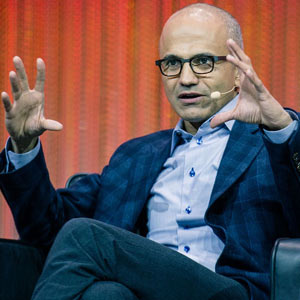Leadership: How did Indian-Americans break the glass ceiling?

Satya Nadela, just a few years ago, would not have made it to the short list of contenders for the top job at the world’s largest software company. Yet, today he is Microsoft’s new CEO. This shows how much the technology industry—and indeed America—has changed.
Microsoft’s new CEO is an exceptional choice, no doubt, but his company has many challenges ahead. Its core market—the PC—is shrinking. Tablets and smartphones—which predominantly run Android and iOS—are eclipsing it. His job won’t be easy. But Satya Nadella has done wonders in building the cloud business, so if anyone can beat the odds, he is the one.
The thought this brings to mind is: what if Microsoft was recruiting only on the basis of the old stereotypes? It would have missed out on hiring the right candidate.
When Vijay Vashee joined Microsoft in 1982 he was just one of two Indians at the 160-person company. It added several more recruits from India, mostly IIT-ians, over the years. They held low-level technical positions. Vashee became the first Indian to break through Microsoft’s glass ceiling in 1988 when he was named General Manager for Microsoft Project. In 1992 he was asked to head the fledgling PowerPoint division and helped grow this from $100 million to a billion-dollar business.
About the same time as Vashee, Indians in Silicon Valley began breaking glass ceilings. They all faced the same hurdles: a belief that Indians made great engineers but were not capable of becoming managers—certainly not CEOs. A common perception was that they didn’t know how to delegate authority and could not lead companies.
How did the transformation happen? Very simply: Indian-Americans started helping Indian-Americans—regardless of their caste, religion, and regional heritage as well as all others from Bangladesh, Pakistan, and Sri Lanka. They decid-ed to give back to the community that they were now part of.
When the first generation of Indians in Silicon Valley succeeded in shattering the glass ceiling, they decided to help others follow their path. They realized that they had all surmounted the same obstacles. And that they could reduce the barriers to entry for others behind them by sharing their experiences and opening some doors.
They had open discussions about the hurdles they had faced. They concluded that the key to uplifting their community, and fostering more entrepreneurship in general, was to teach and mentor the next generation of entrepreneurs. They formed networking organizations such as TiE (The Indus Entrepreneurs) to teach others about starting businesses, and to bring people together. These organizations helped to mobilize the information, knowhow, skill, and capital needed to start technology companies. The first generation of successful entrepreneurs—people like Vijay Vashee—served as visible, vocal, role models and mentors to the next. And they provided seed funding to members of their community.
This helped Indians achieve extraordinary success. Research by my team at Duke, UC-Berkeley, and Stanford showed that as of 2005, 52.4 percent of Silicon Valley’s companies had a chief executive or lead technologist who was foreign-born, and Indians founded 25.8 percent of these companies. This proportion increased to 33.2 percent in 2012. Indians, who constitute only 6 percent of Silicon Valley’s working population, start roughly 15 percent of its companies. That is quite a feat to achieve in the most competitive, entrepreneurial, and innovative place on this planet.
There are important lessons to be learned here for groups that face discrimination. The key to uplifting a community is mentorship and education—not from outside but from within. It starts by members of the community admitting there is a problem and working together to fix it. They need to give back to their community and “pay it forward.” Everyone who achieves success must help others behind them. They may not get short-term advantage but will definitely gain in the long term as perceptions change and new doors open for the entire community.
That an Indian can lead the world’s top software company is an important milestone for Indian-Americans and for America. But the larger message is for entrepreneurs everywhere: imagine what you can achieve if you put your differences aside and start helping one another.
Vivek Wadhwa, a fellow at the Rock Center for Corporate Governance at Stanford University, is director of research at the Center for Entrepreneurship and Research Commercialization at Duke University’s engineering school, and also distinguished scholar at Singularity University and Emory University.
Enjoyed reading Khabar magazine? Subscribe to Khabar and get a full digital copy of this Indian-American community magazine.
blog comments powered by Disqus












